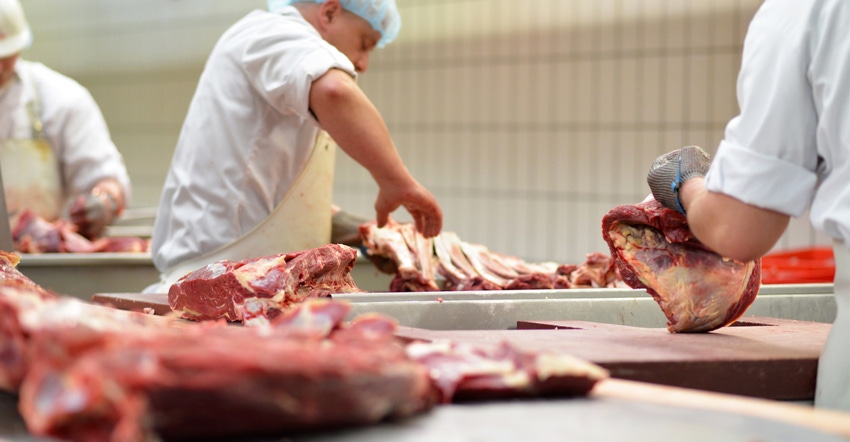February 3, 2022

Wisconsin Farmers Union released a report in January about the decades-long struggles the U.S. meat processing industry has had with consolidation and the impacts on farmers, consumers and workers. In 2020 and 2021, the issues of access to and consolidation within the meat processing sector were highlighted as priority issues by WFU. The grassroots organization convened a task force that developed a network analysis and collected resources to further address issues within meat processing.
Consolidated control
According to the WFU report, multinational meatpackers control 54% of U.S. poultry processing, 70% of U.S. pork packing and 85% of U.S. beef packing. Only 50 meat plants slaughter and process 98% of the U.S. meat supply.
The report also says the farmer’s share of the retail food dollar is only 14 cents.
“Investing in meat processing infrastructure opens the door for farmers to be able to market their animals directly to consumers and regain some control over profit,” the report says.
The dominant corporations in the meat processing industry have been under scrutiny for price fixing, labor rights infringements, misleading labeling and other unsavory practices, the report notes. During the pandemic, the fragility of this highly consolidated system and the impact that has on farmers, consumers and laborers became clear.
“Because of the sheer market share of these corporations and their power to work together to undercut the marketplace, everyone else is suffering. Small and midscale meat processing plants have struggled to compete and are disappearing from the countryside — leaving farmers and eaters with fewer options,” the report says. “As smaller processing options disappear, animals are being shipped further. Farmers who sell directly to consumers often rely on local processors who are uniquely suited to manage smaller harvest runs and custom cutting instructions. Farmers who sell into larger markets, such as the auction barn or through contracting, find themselves subjected to widely fluctuating prices and beholden to livestock specs that skew increasingly in favor of meatpackers, often ignoring the farmer’s cost of production.”
Small and midscale processors also find it difficult to thrive in these conditions. Not only are they competing in a low-margin industry, but also they must work against the power of massive industry players who spread risk over many facilities. It is also difficult to find, hire, train and maintain the skilled workers who can adapt to different roles in a small business and understand the unique cutting needs of a range of different carcasses from regional producers. The large-scale industry can choose to process only certain animals and streamline every cut in a factory-like assembly line.
According to the report, while these two scales of processing ultimately create similar products, they are radically different businesses. “The issue impacts more people than just farmers and those who work in the meat processing industry. Rural communities suffer both cultural and economic impacts as processing businesses disappear — taking jobs and support of other area businesses with them.”
But this isn’t just a rural issue; the freedom of choice for all consumers seeking meat products is affected. As consumers review the brands they see on grocery store shelves, there is a severe lack of transparency about which companies ultimately own each brand, how prices have been determined, and the origin of the meat in the packages in front of them.
WFU outlines several solutions to meatpacking problems in the report, including:
Access to capital is a big struggle for many small processors. Often, physical facilities, aging or smaller-scale equipment, and cold-storage capacity are limiting factors for growth. Improving facilities, capacity and ergonomics are often essential, but require large outlays of capital for these small businesses. Access to low-interest loans or grants would help overcome these obstacles.
Many smaller processing facilities are located in rural areas with relatively small pools of skilled employees. Because of this, many facilities plan some level of on-the-job training for newer employees and focus on staff turnover reduction through other incentives. Reducing the downward price pressure from consolidated industry would help.
Smaller scale processors have to manage a high level of complexity within their businesses as they work with numerous smaller-scale producers and customers.
Consumer education is needed around topics like local foods, labeling and how to purchase directly from farmers, if we want to rebuild regional food systems.
Creating shorter and more diverse supply chains for meat will minimize the carbon-intensity of the livestock industry. Strengthening small and midscale processing supports farmers, many of whom employ sustainable management practices on their farms.
Investing in meat processing is an investment in the security of our food supply, and as the WFU report indicates, it is a necessity.
“Expanding processing capacity opens the door for farmers to regain some control by marketing animals directly to consumers,” says Darin Von Ruden, WFU president. “However, we also need to increase competition and fairness in the marketplace and address misleading labels.”
To view the report, go to wisconsinfarmersunion.com.
Comments? Email [email protected].
You May Also Like




